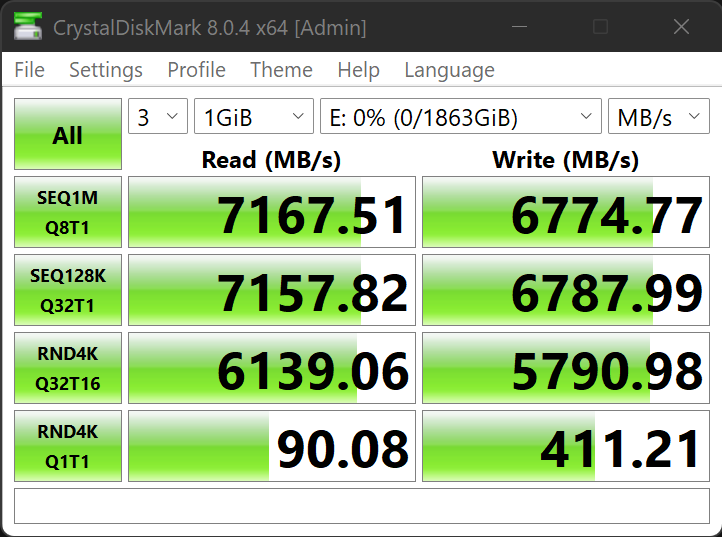CRYSTAL DISK BENCHMARK VER. 8.0.4 x64
Crystal Disk Benchmark is used to measure read and write performance through sampling of random data which is, for the most part, incompressible. Performance is virtually identical, regardless of data sample so we have included only that using random data samples.
THROUGHPUT
IOPS
Throughput of 7.1GB/s read and 6.7GB/s write are impressive throughput, however, read and write random 4K IOPS in the area of 1.5mil is simply unheard of for a consumer SSD!
The toughest benchmark available for solid state drives is AS SSD as it relies solely on incompressible data samples when testing performance. For the most part, AS SSD tests can be considered the ‘worst case scenario’ in obtaining data transfer speeds and many enthusiasts like AS SSD for their needs.
ANVIL STORAGE UTILITIES PROFESSIONAL
Anvil’s Storage Utilities (ASU) are the most complete test bed available for the solid state drive today. The benchmark displays test results for, not only throughput but also, IOPS and Disk Access Times. Not only does it have a preset SSD benchmark, but also, it has included such things as endurance testing and threaded I/O read, write and mixed tests, all of which are very simple to understand and use in our benchmark testing.
AJA VIDEO SYSTEM DISK TEST
The AJA Video Systems Disk Test is relatively new to our testing and tests the transfer speed of video files with different resolutions and Codec.
TxBench is one of our newly discovered benchmarks that we works much the same as Crystal DiskMark, but with several other features. Advanced load benchmarking can be configured, as well as full drive information and data erasing via secure erase, enhanced secure erase, TRIM and overwriting. Simply click on the title for a free copy.
 The SSD Review The Worlds Dedicated SSD Education and Review Resource |
The SSD Review The Worlds Dedicated SSD Education and Review Resource | 


Nowhere in this review did you mention temperatures, requirements for a thermal solution, etc.
Would this be a good option for a PS5? Does it run too hot?
Can someone explain to me why no one makes and sells SLC SSDs today, even though Chinese SSDs on Chinese TLC memory cost a penny? What prevents switching NAND chips from TLC mode to permanent SLC mode, albeit with a loss of 2/3 capacity? But the speed is always the same as in SLC mode and an indestructible resource, plus a data storage time of at least 10 years.
What would a smart buyer prefer if they were offered a 2TB 3D TLC SSD for $100 or a 666GB SLC drive for the same price? Well, yes, I am aware that most people are idiots and marketers rule them …
It’s not a loss of 2/3 of capacity. SLC > MLC > TLC means 2^n so it’s actually 3/4 capacity loss. Basically, it would cost 4 times as much. You also have to consider that NAND density is a huge issue as well.